Comprehensive Strategic Plan for a Coffee Shop Business: Analysis
VerifiedAdded on 2020/03/04
|16
|4233
|54
Project
AI Summary
This document outlines a strategic plan for a coffee shop, detailing its current business model canvas, vision, and mission statements. It analyzes key partnerships, activities, value propositions, customer relationships, resources, distribution channels, and cost and revenue structures. The plan emphasizes technology adoption, including modern coffee makers and near-field communication payment systems, to improve efficiency, customer service, and revenue. A value chain analysis is included to identify areas for differentiation and cost advantage. Future strategies involve self-service technology, expanded payment options, and a reduction in staff costs, alongside plans for increased partnerships and revenue streams. The plan also focuses on the importance of customer data and adapting to technological advancements to achieve strategic goals and overall success.

Running head: STRATEGIC PLAN 1
Develop and submit a strategic plan
Student’s Name:
Institutional Affiliation:
Develop and submit a strategic plan
Student’s Name:
Institutional Affiliation:
Paraphrase This Document
Need a fresh take? Get an instant paraphrase of this document with our AI Paraphraser
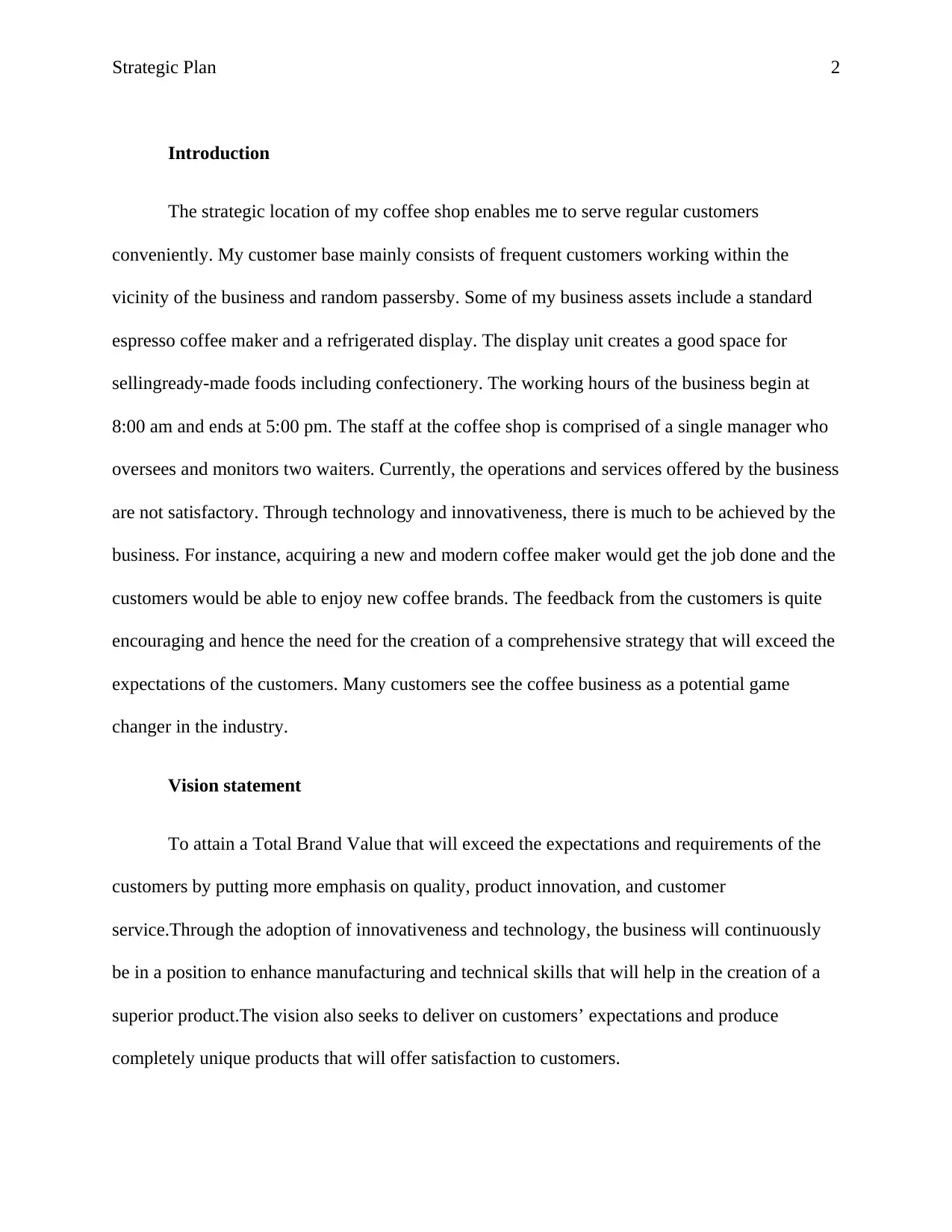
Strategic Plan 2
Introduction
The strategic location of my coffee shop enables me to serve regular customers
conveniently. My customer base mainly consists of frequent customers working within the
vicinity of the business and random passersby. Some of my business assets include a standard
espresso coffee maker and a refrigerated display. The display unit creates a good space for
sellingready-made foods including confectionery. The working hours of the business begin at
8:00 am and ends at 5:00 pm. The staff at the coffee shop is comprised of a single manager who
oversees and monitors two waiters. Currently, the operations and services offered by the business
are not satisfactory. Through technology and innovativeness, there is much to be achieved by the
business. For instance, acquiring a new and modern coffee maker would get the job done and the
customers would be able to enjoy new coffee brands. The feedback from the customers is quite
encouraging and hence the need for the creation of a comprehensive strategy that will exceed the
expectations of the customers. Many customers see the coffee business as a potential game
changer in the industry.
Vision statement
To attain a Total Brand Value that will exceed the expectations and requirements of the
customers by putting more emphasis on quality, product innovation, and customer
service.Through the adoption of innovativeness and technology, the business will continuously
be in a position to enhance manufacturing and technical skills that will help in the creation of a
superior product.The vision also seeks to deliver on customers’ expectations and produce
completely unique products that will offer satisfaction to customers.
Introduction
The strategic location of my coffee shop enables me to serve regular customers
conveniently. My customer base mainly consists of frequent customers working within the
vicinity of the business and random passersby. Some of my business assets include a standard
espresso coffee maker and a refrigerated display. The display unit creates a good space for
sellingready-made foods including confectionery. The working hours of the business begin at
8:00 am and ends at 5:00 pm. The staff at the coffee shop is comprised of a single manager who
oversees and monitors two waiters. Currently, the operations and services offered by the business
are not satisfactory. Through technology and innovativeness, there is much to be achieved by the
business. For instance, acquiring a new and modern coffee maker would get the job done and the
customers would be able to enjoy new coffee brands. The feedback from the customers is quite
encouraging and hence the need for the creation of a comprehensive strategy that will exceed the
expectations of the customers. Many customers see the coffee business as a potential game
changer in the industry.
Vision statement
To attain a Total Brand Value that will exceed the expectations and requirements of the
customers by putting more emphasis on quality, product innovation, and customer
service.Through the adoption of innovativeness and technology, the business will continuously
be in a position to enhance manufacturing and technical skills that will help in the creation of a
superior product.The vision also seeks to deliver on customers’ expectations and produce
completely unique products that will offer satisfaction to customers.
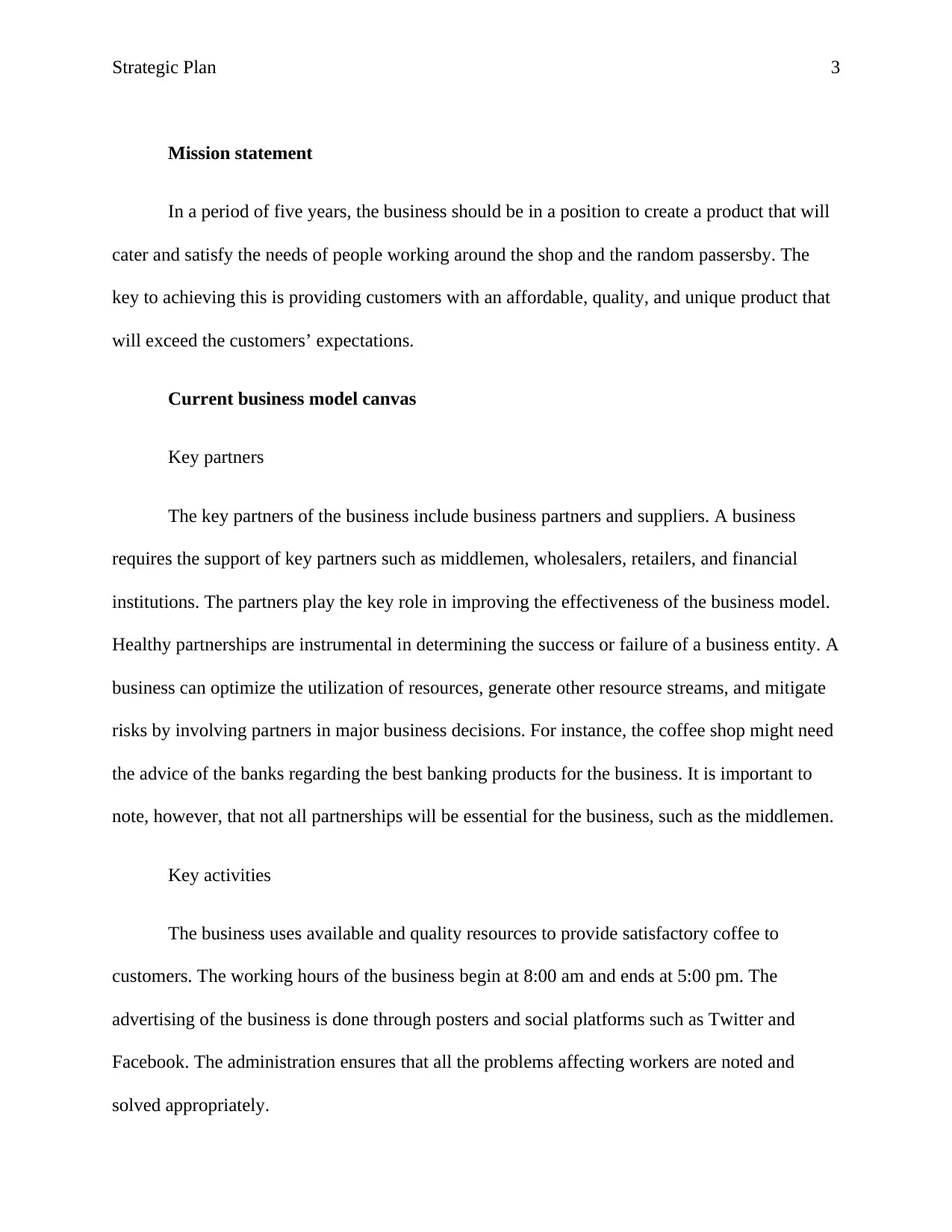
Strategic Plan 3
Mission statement
In a period of five years, the business should be in a position to create a product that will
cater and satisfy the needs of people working around the shop and the random passersby. The
key to achieving this is providing customers with an affordable, quality, and unique product that
will exceed the customers’ expectations.
Current business model canvas
Key partners
The key partners of the business include business partners and suppliers. A business
requires the support of key partners such as middlemen, wholesalers, retailers, and financial
institutions. The partners play the key role in improving the effectiveness of the business model.
Healthy partnerships are instrumental in determining the success or failure of a business entity. A
business can optimize the utilization of resources, generate other resource streams, and mitigate
risks by involving partners in major business decisions. For instance, the coffee shop might need
the advice of the banks regarding the best banking products for the business. It is important to
note, however, that not all partnerships will be essential for the business, such as the middlemen.
Key activities
The business uses available and quality resources to provide satisfactory coffee to
customers. The working hours of the business begin at 8:00 am and ends at 5:00 pm. The
advertising of the business is done through posters and social platforms such as Twitter and
Facebook. The administration ensures that all the problems affecting workers are noted and
solved appropriately.
Mission statement
In a period of five years, the business should be in a position to create a product that will
cater and satisfy the needs of people working around the shop and the random passersby. The
key to achieving this is providing customers with an affordable, quality, and unique product that
will exceed the customers’ expectations.
Current business model canvas
Key partners
The key partners of the business include business partners and suppliers. A business
requires the support of key partners such as middlemen, wholesalers, retailers, and financial
institutions. The partners play the key role in improving the effectiveness of the business model.
Healthy partnerships are instrumental in determining the success or failure of a business entity. A
business can optimize the utilization of resources, generate other resource streams, and mitigate
risks by involving partners in major business decisions. For instance, the coffee shop might need
the advice of the banks regarding the best banking products for the business. It is important to
note, however, that not all partnerships will be essential for the business, such as the middlemen.
Key activities
The business uses available and quality resources to provide satisfactory coffee to
customers. The working hours of the business begin at 8:00 am and ends at 5:00 pm. The
advertising of the business is done through posters and social platforms such as Twitter and
Facebook. The administration ensures that all the problems affecting workers are noted and
solved appropriately.
⊘ This is a preview!⊘
Do you want full access?
Subscribe today to unlock all pages.

Trusted by 1+ million students worldwide
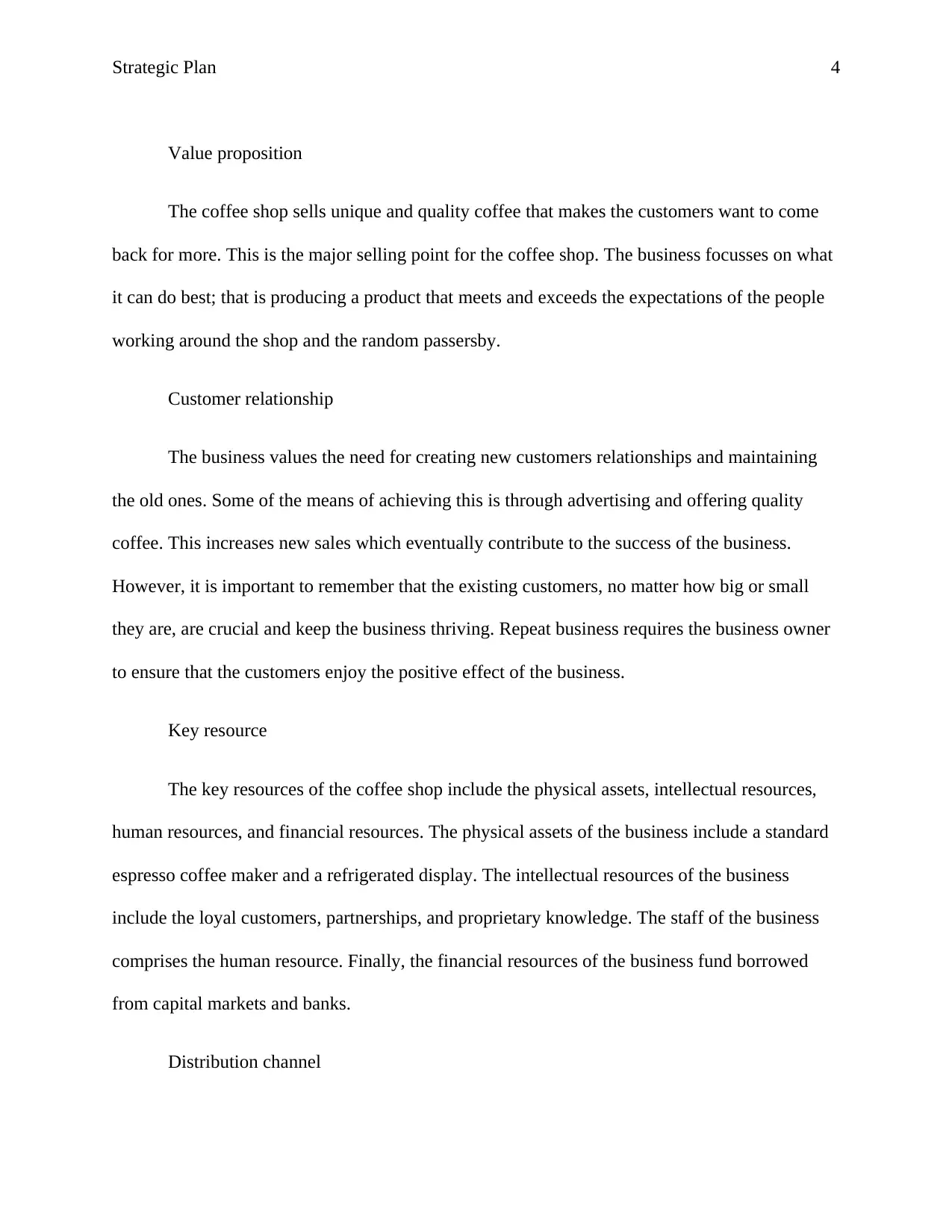
Strategic Plan 4
Value proposition
The coffee shop sells unique and quality coffee that makes the customers want to come
back for more. This is the major selling point for the coffee shop. The business focusses on what
it can do best; that is producing a product that meets and exceeds the expectations of the people
working around the shop and the random passersby.
Customer relationship
The business values the need for creating new customers relationships and maintaining
the old ones. Some of the means of achieving this is through advertising and offering quality
coffee. This increases new sales which eventually contribute to the success of the business.
However, it is important to remember that the existing customers, no matter how big or small
they are, are crucial and keep the business thriving. Repeat business requires the business owner
to ensure that the customers enjoy the positive effect of the business.
Key resource
The key resources of the coffee shop include the physical assets, intellectual resources,
human resources, and financial resources. The physical assets of the business include a standard
espresso coffee maker and a refrigerated display. The intellectual resources of the business
include the loyal customers, partnerships, and proprietary knowledge. The staff of the business
comprises the human resource. Finally, the financial resources of the business fund borrowed
from capital markets and banks.
Distribution channel
Value proposition
The coffee shop sells unique and quality coffee that makes the customers want to come
back for more. This is the major selling point for the coffee shop. The business focusses on what
it can do best; that is producing a product that meets and exceeds the expectations of the people
working around the shop and the random passersby.
Customer relationship
The business values the need for creating new customers relationships and maintaining
the old ones. Some of the means of achieving this is through advertising and offering quality
coffee. This increases new sales which eventually contribute to the success of the business.
However, it is important to remember that the existing customers, no matter how big or small
they are, are crucial and keep the business thriving. Repeat business requires the business owner
to ensure that the customers enjoy the positive effect of the business.
Key resource
The key resources of the coffee shop include the physical assets, intellectual resources,
human resources, and financial resources. The physical assets of the business include a standard
espresso coffee maker and a refrigerated display. The intellectual resources of the business
include the loyal customers, partnerships, and proprietary knowledge. The staff of the business
comprises the human resource. Finally, the financial resources of the business fund borrowed
from capital markets and banks.
Distribution channel
Paraphrase This Document
Need a fresh take? Get an instant paraphrase of this document with our AI Paraphraser
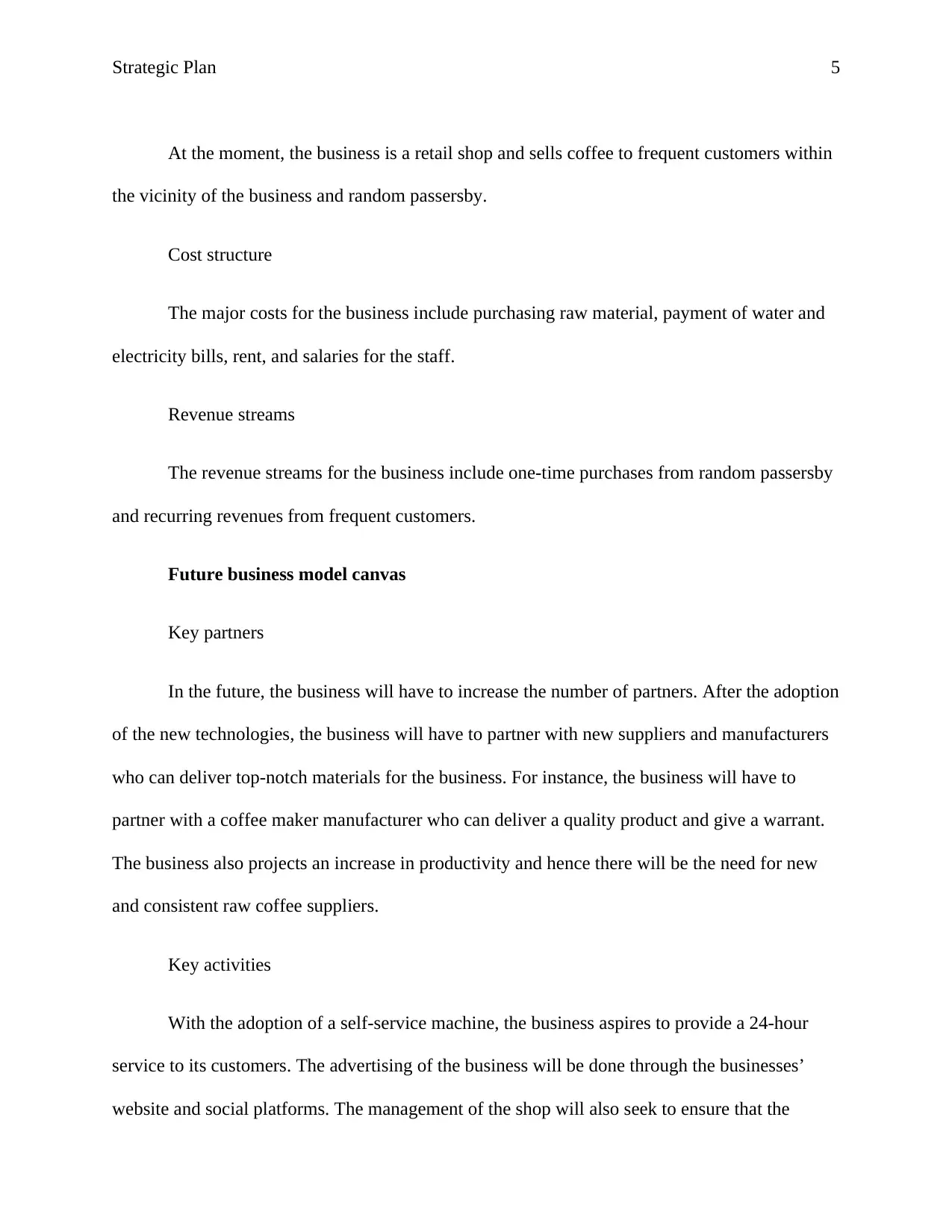
Strategic Plan 5
At the moment, the business is a retail shop and sells coffee to frequent customers within
the vicinity of the business and random passersby.
Cost structure
The major costs for the business include purchasing raw material, payment of water and
electricity bills, rent, and salaries for the staff.
Revenue streams
The revenue streams for the business include one-time purchases from random passersby
and recurring revenues from frequent customers.
Future business model canvas
Key partners
In the future, the business will have to increase the number of partners. After the adoption
of the new technologies, the business will have to partner with new suppliers and manufacturers
who can deliver top-notch materials for the business. For instance, the business will have to
partner with a coffee maker manufacturer who can deliver a quality product and give a warrant.
The business also projects an increase in productivity and hence there will be the need for new
and consistent raw coffee suppliers.
Key activities
With the adoption of a self-service machine, the business aspires to provide a 24-hour
service to its customers. The advertising of the business will be done through the businesses’
website and social platforms. The management of the shop will also seek to ensure that the
At the moment, the business is a retail shop and sells coffee to frequent customers within
the vicinity of the business and random passersby.
Cost structure
The major costs for the business include purchasing raw material, payment of water and
electricity bills, rent, and salaries for the staff.
Revenue streams
The revenue streams for the business include one-time purchases from random passersby
and recurring revenues from frequent customers.
Future business model canvas
Key partners
In the future, the business will have to increase the number of partners. After the adoption
of the new technologies, the business will have to partner with new suppliers and manufacturers
who can deliver top-notch materials for the business. For instance, the business will have to
partner with a coffee maker manufacturer who can deliver a quality product and give a warrant.
The business also projects an increase in productivity and hence there will be the need for new
and consistent raw coffee suppliers.
Key activities
With the adoption of a self-service machine, the business aspires to provide a 24-hour
service to its customers. The advertising of the business will be done through the businesses’
website and social platforms. The management of the shop will also seek to ensure that the
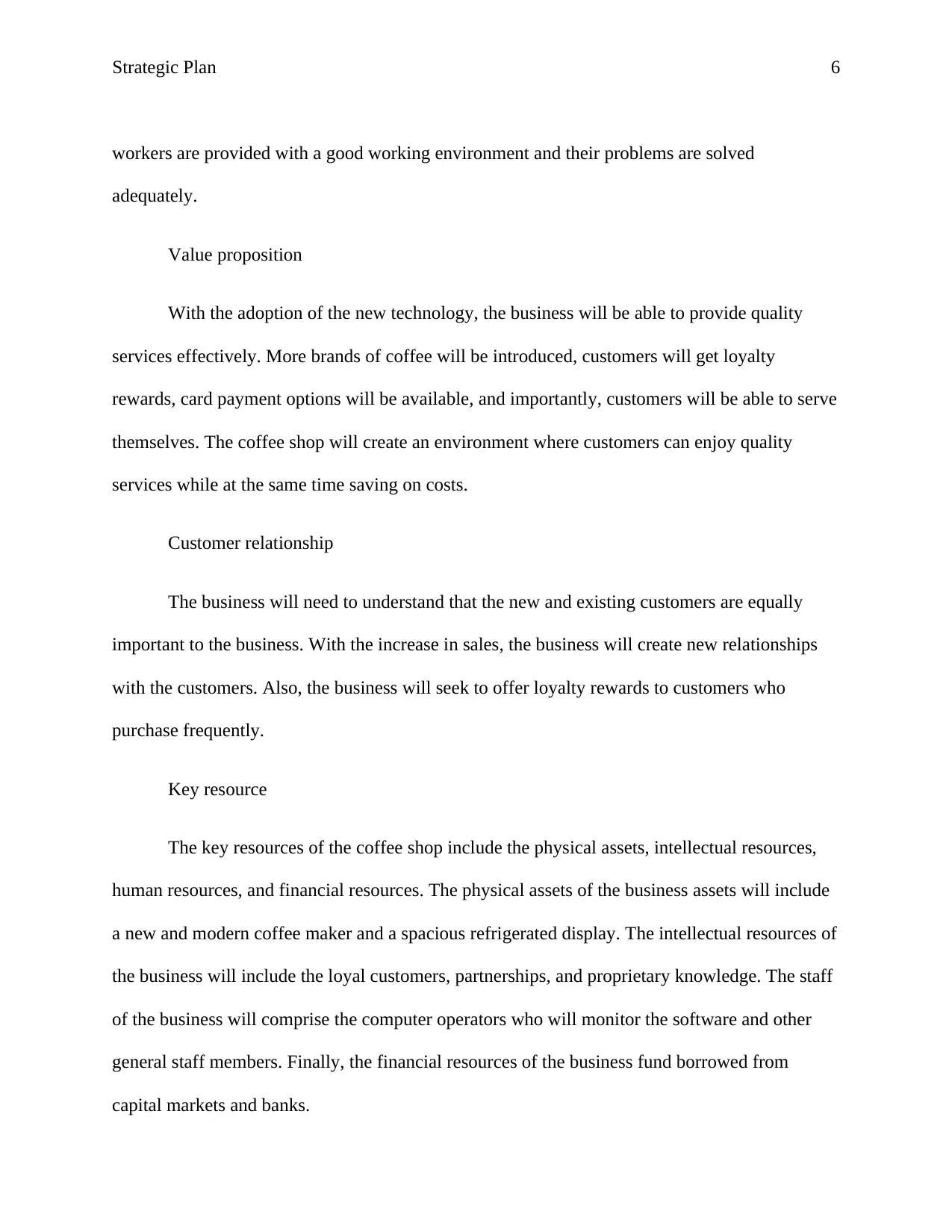
Strategic Plan 6
workers are provided with a good working environment and their problems are solved
adequately.
Value proposition
With the adoption of the new technology, the business will be able to provide quality
services effectively. More brands of coffee will be introduced, customers will get loyalty
rewards, card payment options will be available, and importantly, customers will be able to serve
themselves. The coffee shop will create an environment where customers can enjoy quality
services while at the same time saving on costs.
Customer relationship
The business will need to understand that the new and existing customers are equally
important to the business. With the increase in sales, the business will create new relationships
with the customers. Also, the business will seek to offer loyalty rewards to customers who
purchase frequently.
Key resource
The key resources of the coffee shop include the physical assets, intellectual resources,
human resources, and financial resources. The physical assets of the business assets will include
a new and modern coffee maker and a spacious refrigerated display. The intellectual resources of
the business will include the loyal customers, partnerships, and proprietary knowledge. The staff
of the business will comprise the computer operators who will monitor the software and other
general staff members. Finally, the financial resources of the business fund borrowed from
capital markets and banks.
workers are provided with a good working environment and their problems are solved
adequately.
Value proposition
With the adoption of the new technology, the business will be able to provide quality
services effectively. More brands of coffee will be introduced, customers will get loyalty
rewards, card payment options will be available, and importantly, customers will be able to serve
themselves. The coffee shop will create an environment where customers can enjoy quality
services while at the same time saving on costs.
Customer relationship
The business will need to understand that the new and existing customers are equally
important to the business. With the increase in sales, the business will create new relationships
with the customers. Also, the business will seek to offer loyalty rewards to customers who
purchase frequently.
Key resource
The key resources of the coffee shop include the physical assets, intellectual resources,
human resources, and financial resources. The physical assets of the business assets will include
a new and modern coffee maker and a spacious refrigerated display. The intellectual resources of
the business will include the loyal customers, partnerships, and proprietary knowledge. The staff
of the business will comprise the computer operators who will monitor the software and other
general staff members. Finally, the financial resources of the business fund borrowed from
capital markets and banks.
⊘ This is a preview!⊘
Do you want full access?
Subscribe today to unlock all pages.

Trusted by 1+ million students worldwide
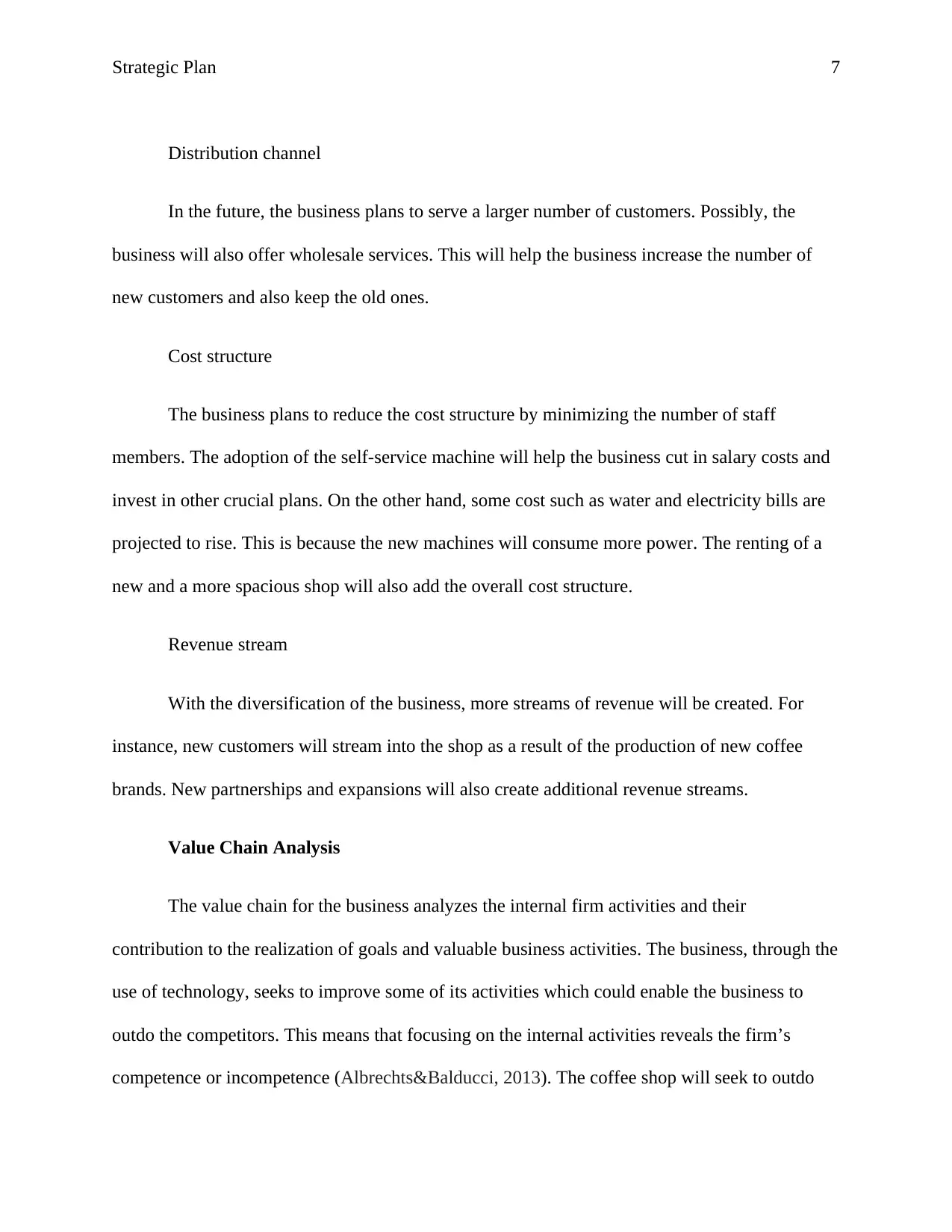
Strategic Plan 7
Distribution channel
In the future, the business plans to serve a larger number of customers. Possibly, the
business will also offer wholesale services. This will help the business increase the number of
new customers and also keep the old ones.
Cost structure
The business plans to reduce the cost structure by minimizing the number of staff
members. The adoption of the self-service machine will help the business cut in salary costs and
invest in other crucial plans. On the other hand, some cost such as water and electricity bills are
projected to rise. This is because the new machines will consume more power. The renting of a
new and a more spacious shop will also add the overall cost structure.
Revenue stream
With the diversification of the business, more streams of revenue will be created. For
instance, new customers will stream into the shop as a result of the production of new coffee
brands. New partnerships and expansions will also create additional revenue streams.
Value Chain Analysis
The value chain for the business analyzes the internal firm activities and their
contribution to the realization of goals and valuable business activities. The business, through the
use of technology, seeks to improve some of its activities which could enable the business to
outdo the competitors. This means that focusing on the internal activities reveals the firm’s
competence or incompetence (Albrechts&Balducci, 2013). The coffee shop will seek to outdo
Distribution channel
In the future, the business plans to serve a larger number of customers. Possibly, the
business will also offer wholesale services. This will help the business increase the number of
new customers and also keep the old ones.
Cost structure
The business plans to reduce the cost structure by minimizing the number of staff
members. The adoption of the self-service machine will help the business cut in salary costs and
invest in other crucial plans. On the other hand, some cost such as water and electricity bills are
projected to rise. This is because the new machines will consume more power. The renting of a
new and a more spacious shop will also add the overall cost structure.
Revenue stream
With the diversification of the business, more streams of revenue will be created. For
instance, new customers will stream into the shop as a result of the production of new coffee
brands. New partnerships and expansions will also create additional revenue streams.
Value Chain Analysis
The value chain for the business analyzes the internal firm activities and their
contribution to the realization of goals and valuable business activities. The business, through the
use of technology, seeks to improve some of its activities which could enable the business to
outdo the competitors. This means that focusing on the internal activities reveals the firm’s
competence or incompetence (Albrechts&Balducci, 2013). The coffee shop will seek to outdo
Paraphrase This Document
Need a fresh take? Get an instant paraphrase of this document with our AI Paraphraser
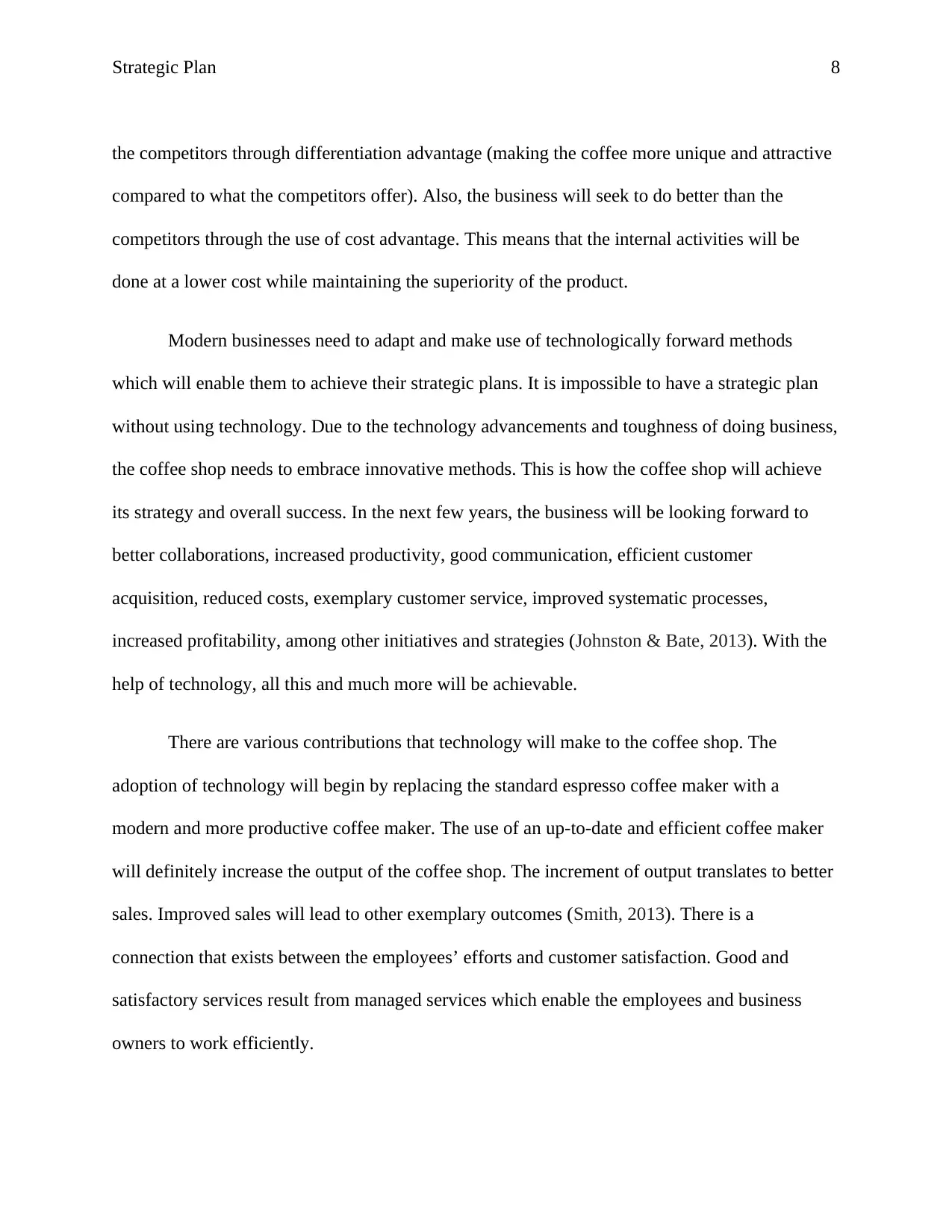
Strategic Plan 8
the competitors through differentiation advantage (making the coffee more unique and attractive
compared to what the competitors offer). Also, the business will seek to do better than the
competitors through the use of cost advantage. This means that the internal activities will be
done at a lower cost while maintaining the superiority of the product.
Modern businesses need to adapt and make use of technologically forward methods
which will enable them to achieve their strategic plans. It is impossible to have a strategic plan
without using technology. Due to the technology advancements and toughness of doing business,
the coffee shop needs to embrace innovative methods. This is how the coffee shop will achieve
its strategy and overall success. In the next few years, the business will be looking forward to
better collaborations, increased productivity, good communication, efficient customer
acquisition, reduced costs, exemplary customer service, improved systematic processes,
increased profitability, among other initiatives and strategies (Johnston & Bate, 2013). With the
help of technology, all this and much more will be achievable.
There are various contributions that technology will make to the coffee shop. The
adoption of technology will begin by replacing the standard espresso coffee maker with a
modern and more productive coffee maker. The use of an up-to-date and efficient coffee maker
will definitely increase the output of the coffee shop. The increment of output translates to better
sales. Improved sales will lead to other exemplary outcomes (Smith, 2013). There is a
connection that exists between the employees’ efforts and customer satisfaction. Good and
satisfactory services result from managed services which enable the employees and business
owners to work efficiently.
the competitors through differentiation advantage (making the coffee more unique and attractive
compared to what the competitors offer). Also, the business will seek to do better than the
competitors through the use of cost advantage. This means that the internal activities will be
done at a lower cost while maintaining the superiority of the product.
Modern businesses need to adapt and make use of technologically forward methods
which will enable them to achieve their strategic plans. It is impossible to have a strategic plan
without using technology. Due to the technology advancements and toughness of doing business,
the coffee shop needs to embrace innovative methods. This is how the coffee shop will achieve
its strategy and overall success. In the next few years, the business will be looking forward to
better collaborations, increased productivity, good communication, efficient customer
acquisition, reduced costs, exemplary customer service, improved systematic processes,
increased profitability, among other initiatives and strategies (Johnston & Bate, 2013). With the
help of technology, all this and much more will be achievable.
There are various contributions that technology will make to the coffee shop. The
adoption of technology will begin by replacing the standard espresso coffee maker with a
modern and more productive coffee maker. The use of an up-to-date and efficient coffee maker
will definitely increase the output of the coffee shop. The increment of output translates to better
sales. Improved sales will lead to other exemplary outcomes (Smith, 2013). There is a
connection that exists between the employees’ efforts and customer satisfaction. Good and
satisfactory services result from managed services which enable the employees and business
owners to work efficiently.
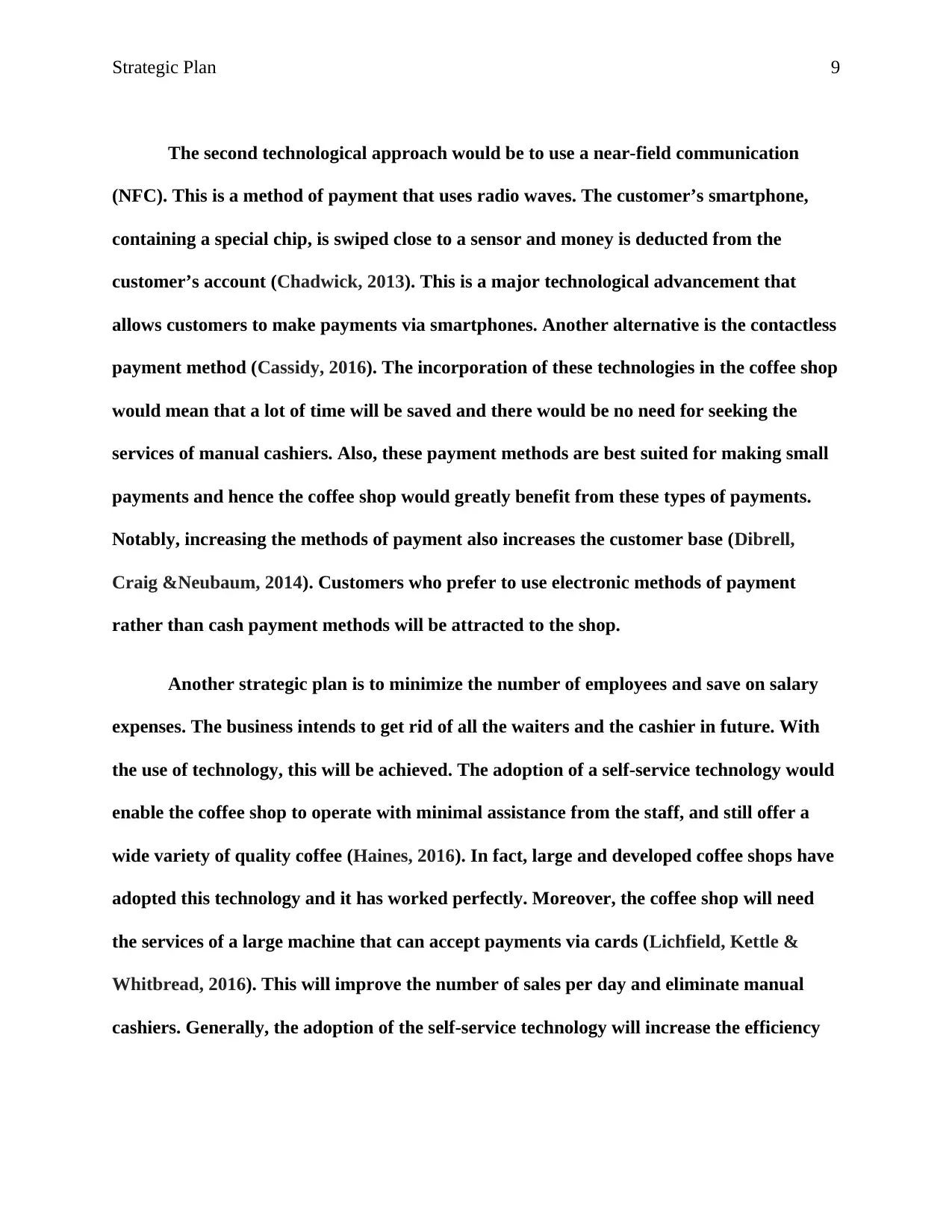
Strategic Plan 9
The second technological approach would be to use a near-field communication
(NFC). This is a method of payment that uses radio waves. The customer’s smartphone,
containing a special chip, is swiped close to a sensor and money is deducted from the
customer’s account (Chadwick, 2013). This is a major technological advancement that
allows customers to make payments via smartphones. Another alternative is the contactless
payment method (Cassidy, 2016). The incorporation of these technologies in the coffee shop
would mean that a lot of time will be saved and there would be no need for seeking the
services of manual cashiers. Also, these payment methods are best suited for making small
payments and hence the coffee shop would greatly benefit from these types of payments.
Notably, increasing the methods of payment also increases the customer base (Dibrell,
Craig &Neubaum, 2014). Customers who prefer to use electronic methods of payment
rather than cash payment methods will be attracted to the shop.
Another strategic plan is to minimize the number of employees and save on salary
expenses. The business intends to get rid of all the waiters and the cashier in future. With
the use of technology, this will be achieved. The adoption of a self-service technology would
enable the coffee shop to operate with minimal assistance from the staff, and still offer a
wide variety of quality coffee (Haines, 2016). In fact, large and developed coffee shops have
adopted this technology and it has worked perfectly. Moreover, the coffee shop will need
the services of a large machine that can accept payments via cards (Lichfield, Kettle &
Whitbread, 2016). This will improve the number of sales per day and eliminate manual
cashiers. Generally, the adoption of the self-service technology will increase the efficiency
The second technological approach would be to use a near-field communication
(NFC). This is a method of payment that uses radio waves. The customer’s smartphone,
containing a special chip, is swiped close to a sensor and money is deducted from the
customer’s account (Chadwick, 2013). This is a major technological advancement that
allows customers to make payments via smartphones. Another alternative is the contactless
payment method (Cassidy, 2016). The incorporation of these technologies in the coffee shop
would mean that a lot of time will be saved and there would be no need for seeking the
services of manual cashiers. Also, these payment methods are best suited for making small
payments and hence the coffee shop would greatly benefit from these types of payments.
Notably, increasing the methods of payment also increases the customer base (Dibrell,
Craig &Neubaum, 2014). Customers who prefer to use electronic methods of payment
rather than cash payment methods will be attracted to the shop.
Another strategic plan is to minimize the number of employees and save on salary
expenses. The business intends to get rid of all the waiters and the cashier in future. With
the use of technology, this will be achieved. The adoption of a self-service technology would
enable the coffee shop to operate with minimal assistance from the staff, and still offer a
wide variety of quality coffee (Haines, 2016). In fact, large and developed coffee shops have
adopted this technology and it has worked perfectly. Moreover, the coffee shop will need
the services of a large machine that can accept payments via cards (Lichfield, Kettle &
Whitbread, 2016). This will improve the number of sales per day and eliminate manual
cashiers. Generally, the adoption of the self-service technology will increase the efficiency
⊘ This is a preview!⊘
Do you want full access?
Subscribe today to unlock all pages.

Trusted by 1+ million students worldwide
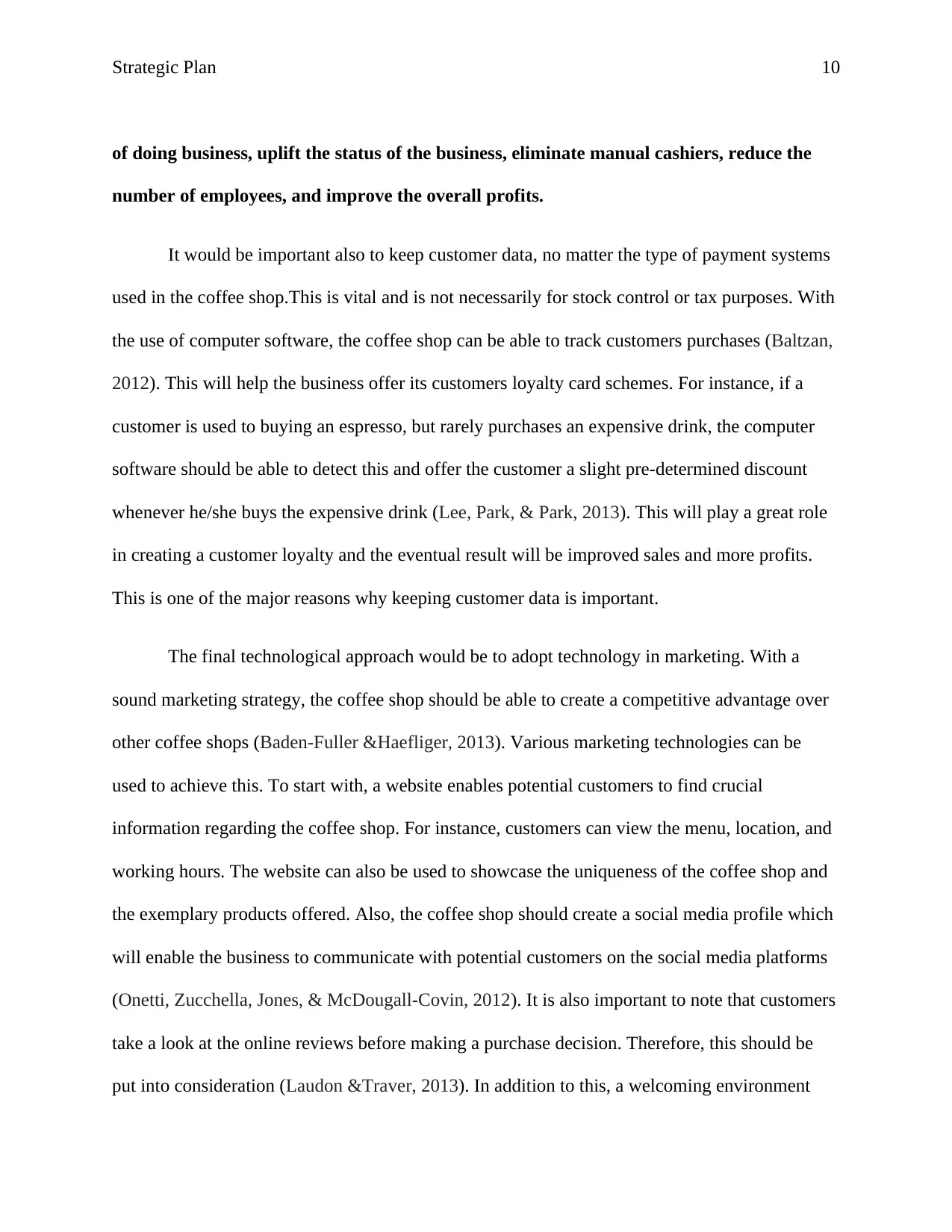
Strategic Plan 10
of doing business, uplift the status of the business, eliminate manual cashiers, reduce the
number of employees, and improve the overall profits.
It would be important also to keep customer data, no matter the type of payment systems
used in the coffee shop.This is vital and is not necessarily for stock control or tax purposes. With
the use of computer software, the coffee shop can be able to track customers purchases (Baltzan,
2012). This will help the business offer its customers loyalty card schemes. For instance, if a
customer is used to buying an espresso, but rarely purchases an expensive drink, the computer
software should be able to detect this and offer the customer a slight pre-determined discount
whenever he/she buys the expensive drink (Lee, Park, & Park, 2013). This will play a great role
in creating a customer loyalty and the eventual result will be improved sales and more profits.
This is one of the major reasons why keeping customer data is important.
The final technological approach would be to adopt technology in marketing. With a
sound marketing strategy, the coffee shop should be able to create a competitive advantage over
other coffee shops (Baden-Fuller &Haefliger, 2013). Various marketing technologies can be
used to achieve this. To start with, a website enables potential customers to find crucial
information regarding the coffee shop. For instance, customers can view the menu, location, and
working hours. The website can also be used to showcase the uniqueness of the coffee shop and
the exemplary products offered. Also, the coffee shop should create a social media profile which
will enable the business to communicate with potential customers on the social media platforms
(Onetti, Zucchella, Jones, & McDougall-Covin, 2012). It is also important to note that customers
take a look at the online reviews before making a purchase decision. Therefore, this should be
put into consideration (Laudon &Traver, 2013). In addition to this, a welcoming environment
of doing business, uplift the status of the business, eliminate manual cashiers, reduce the
number of employees, and improve the overall profits.
It would be important also to keep customer data, no matter the type of payment systems
used in the coffee shop.This is vital and is not necessarily for stock control or tax purposes. With
the use of computer software, the coffee shop can be able to track customers purchases (Baltzan,
2012). This will help the business offer its customers loyalty card schemes. For instance, if a
customer is used to buying an espresso, but rarely purchases an expensive drink, the computer
software should be able to detect this and offer the customer a slight pre-determined discount
whenever he/she buys the expensive drink (Lee, Park, & Park, 2013). This will play a great role
in creating a customer loyalty and the eventual result will be improved sales and more profits.
This is one of the major reasons why keeping customer data is important.
The final technological approach would be to adopt technology in marketing. With a
sound marketing strategy, the coffee shop should be able to create a competitive advantage over
other coffee shops (Baden-Fuller &Haefliger, 2013). Various marketing technologies can be
used to achieve this. To start with, a website enables potential customers to find crucial
information regarding the coffee shop. For instance, customers can view the menu, location, and
working hours. The website can also be used to showcase the uniqueness of the coffee shop and
the exemplary products offered. Also, the coffee shop should create a social media profile which
will enable the business to communicate with potential customers on the social media platforms
(Onetti, Zucchella, Jones, & McDougall-Covin, 2012). It is also important to note that customers
take a look at the online reviews before making a purchase decision. Therefore, this should be
put into consideration (Laudon &Traver, 2013). In addition to this, a welcoming environment
Paraphrase This Document
Need a fresh take? Get an instant paraphrase of this document with our AI Paraphraser
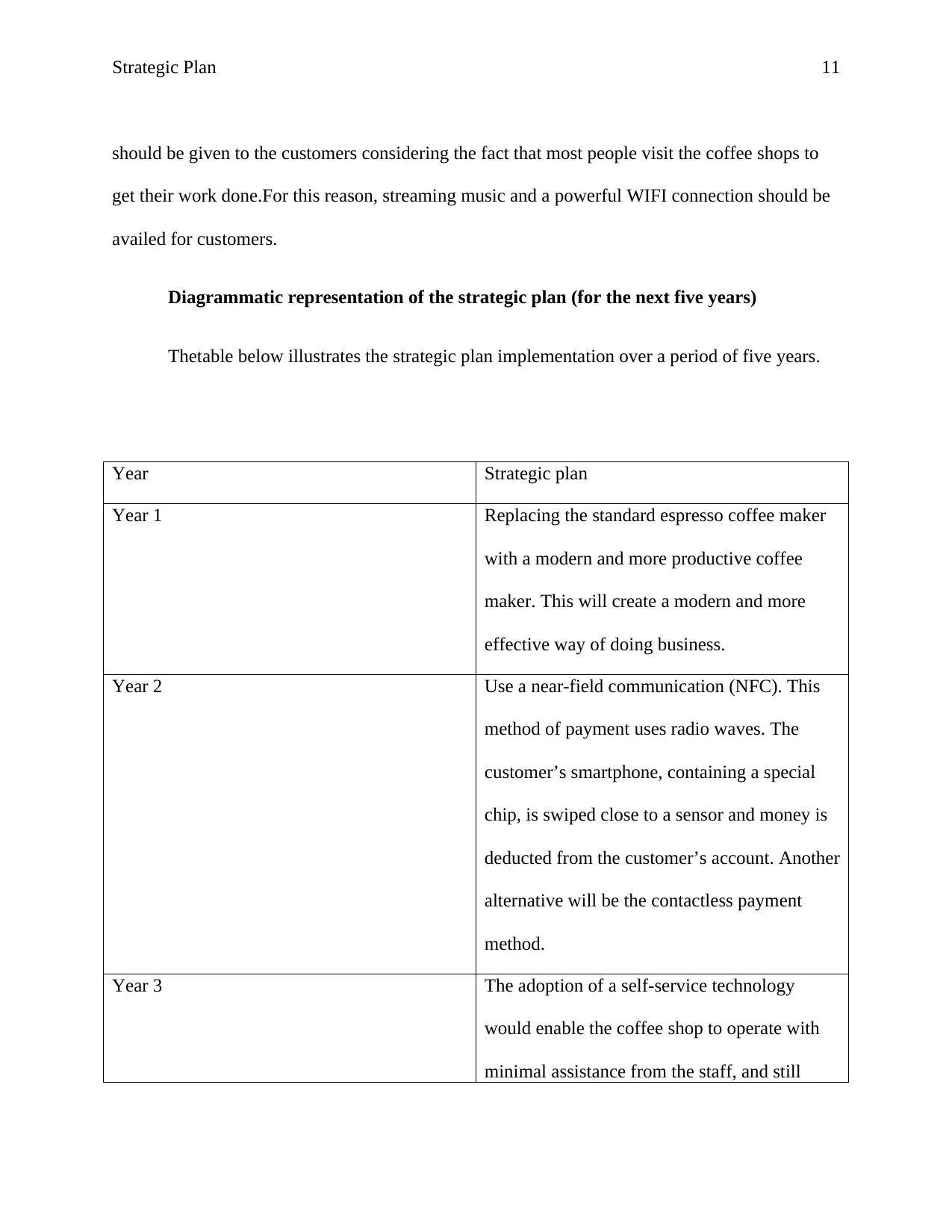
Strategic Plan 11
should be given to the customers considering the fact that most people visit the coffee shops to
get their work done.For this reason, streaming music and a powerful WIFI connection should be
availed for customers.
Diagrammatic representation of the strategic plan (for the next five years)
Thetable below illustrates the strategic plan implementation over a period of five years.
Year Strategic plan
Year 1 Replacing the standard espresso coffee maker
with a modern and more productive coffee
maker. This will create a modern and more
effective way of doing business.
Year 2 Use a near-field communication (NFC). This
method of payment uses radio waves. The
customer’s smartphone, containing a special
chip, is swiped close to a sensor and money is
deducted from the customer’s account. Another
alternative will be the contactless payment
method.
Year 3 The adoption of a self-service technology
would enable the coffee shop to operate with
minimal assistance from the staff, and still
should be given to the customers considering the fact that most people visit the coffee shops to
get their work done.For this reason, streaming music and a powerful WIFI connection should be
availed for customers.
Diagrammatic representation of the strategic plan (for the next five years)
Thetable below illustrates the strategic plan implementation over a period of five years.
Year Strategic plan
Year 1 Replacing the standard espresso coffee maker
with a modern and more productive coffee
maker. This will create a modern and more
effective way of doing business.
Year 2 Use a near-field communication (NFC). This
method of payment uses radio waves. The
customer’s smartphone, containing a special
chip, is swiped close to a sensor and money is
deducted from the customer’s account. Another
alternative will be the contactless payment
method.
Year 3 The adoption of a self-service technology
would enable the coffee shop to operate with
minimal assistance from the staff, and still
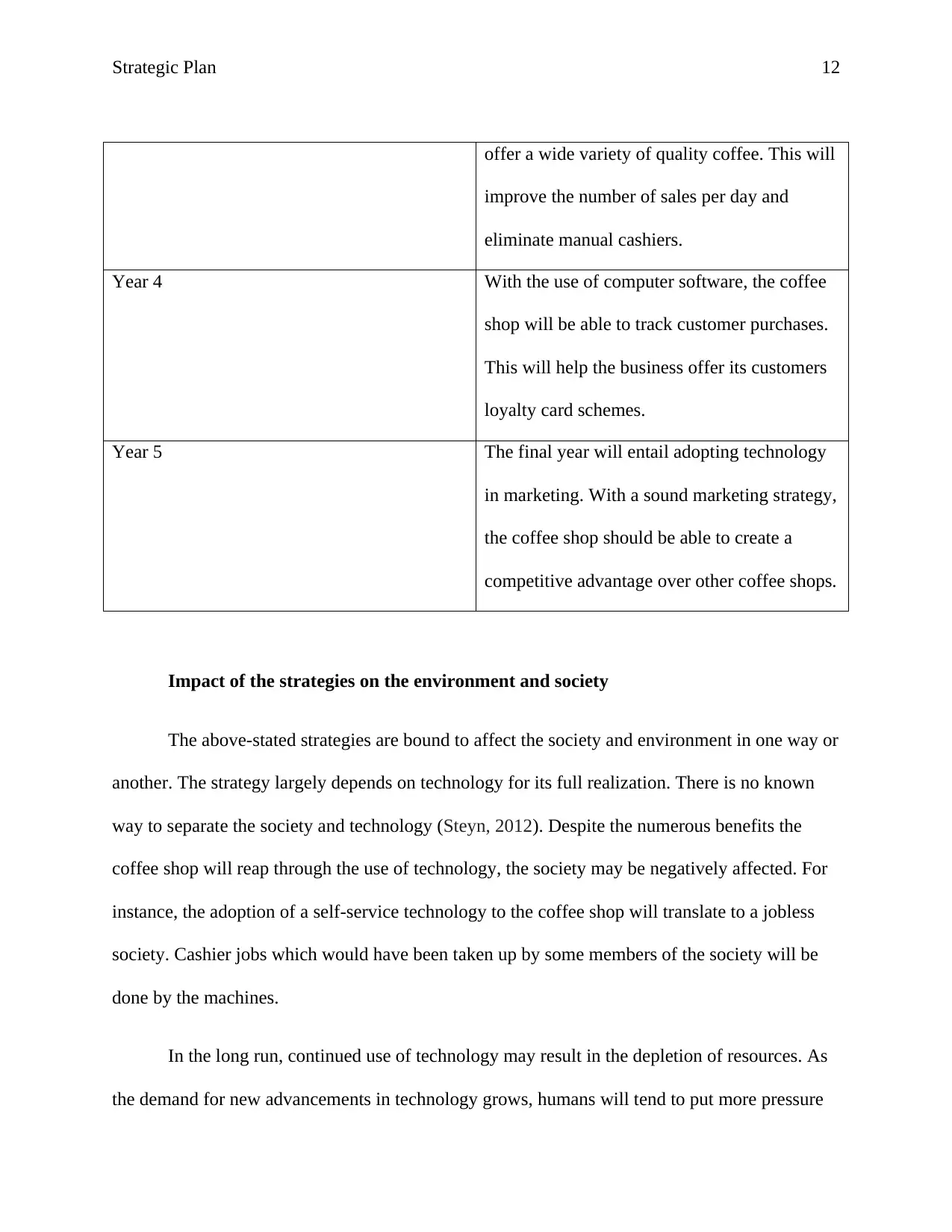
Strategic Plan 12
offer a wide variety of quality coffee. This will
improve the number of sales per day and
eliminate manual cashiers.
Year 4 With the use of computer software, the coffee
shop will be able to track customer purchases.
This will help the business offer its customers
loyalty card schemes.
Year 5 The final year will entail adopting technology
in marketing. With a sound marketing strategy,
the coffee shop should be able to create a
competitive advantage over other coffee shops.
Impact of the strategies on the environment and society
The above-stated strategies are bound to affect the society and environment in one way or
another. The strategy largely depends on technology for its full realization. There is no known
way to separate the society and technology (Steyn, 2012). Despite the numerous benefits the
coffee shop will reap through the use of technology, the society may be negatively affected. For
instance, the adoption of a self-service technology to the coffee shop will translate to a jobless
society. Cashier jobs which would have been taken up by some members of the society will be
done by the machines.
In the long run, continued use of technology may result in the depletion of resources. As
the demand for new advancements in technology grows, humans will tend to put more pressure
offer a wide variety of quality coffee. This will
improve the number of sales per day and
eliminate manual cashiers.
Year 4 With the use of computer software, the coffee
shop will be able to track customer purchases.
This will help the business offer its customers
loyalty card schemes.
Year 5 The final year will entail adopting technology
in marketing. With a sound marketing strategy,
the coffee shop should be able to create a
competitive advantage over other coffee shops.
Impact of the strategies on the environment and society
The above-stated strategies are bound to affect the society and environment in one way or
another. The strategy largely depends on technology for its full realization. There is no known
way to separate the society and technology (Steyn, 2012). Despite the numerous benefits the
coffee shop will reap through the use of technology, the society may be negatively affected. For
instance, the adoption of a self-service technology to the coffee shop will translate to a jobless
society. Cashier jobs which would have been taken up by some members of the society will be
done by the machines.
In the long run, continued use of technology may result in the depletion of resources. As
the demand for new advancements in technology grows, humans will tend to put more pressure
⊘ This is a preview!⊘
Do you want full access?
Subscribe today to unlock all pages.

Trusted by 1+ million students worldwide
1 out of 16
Your All-in-One AI-Powered Toolkit for Academic Success.
+13062052269
info@desklib.com
Available 24*7 on WhatsApp / Email
![[object Object]](/_next/static/media/star-bottom.7253800d.svg)
Unlock your academic potential
Copyright © 2020–2025 A2Z Services. All Rights Reserved. Developed and managed by ZUCOL.